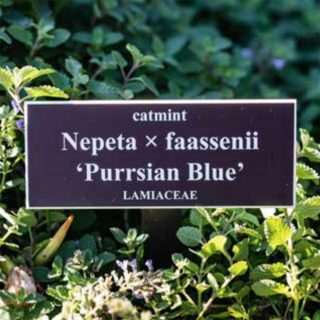[Sic]kening Plant Names: Intentional Orthographic Variants
Posted in Interesting Plant Stories on January 21, 2020 by Kristine Paulus
Kristine Paulus is the Plant Records Manager at The New York Botanical Garden.
 Plant recorders (people who keep records of plants) are frequently assumed to know all the names of every plant. While we may not actually have every plant name committed to memory, we do ensure that plants in the collection are referred to by their proper names. That is to say, the current taxonomically correct and accepted scientific name. So who gets to name plants? There is no authority over the common names—those vernacular nicknames that vary from one geographic region to another. While they can be memorably descriptive, common names can be confusing. Calling an Abutilon a flowering “maple” just doesn’t make sense. Scientific names, however, are the universally accepted names of plants.
Plant recorders (people who keep records of plants) are frequently assumed to know all the names of every plant. While we may not actually have every plant name committed to memory, we do ensure that plants in the collection are referred to by their proper names. That is to say, the current taxonomically correct and accepted scientific name. So who gets to name plants? There is no authority over the common names—those vernacular nicknames that vary from one geographic region to another. While they can be memorably descriptive, common names can be confusing. Calling an Abutilon a flowering “maple” just doesn’t make sense. Scientific names, however, are the universally accepted names of plants.
The revered manual that dictates exactly how plants can be named is The International Code of Botanical Nomenclature (affectionately known to recorders as simply The Code). Once a plant name is published, that is its name (unless further research leads to reclassification). Numerous authoritative sources compile valid plant names, such as Kew’s Plants of the World Online and the Angiosperm Phylogeny Group, allowing plant recorders to check the names and make sure they are accessioned and labeled correctly.
Cultivar names, on the other hand, are slightly less regulated though ideally registered with a cultivar authority, such as The Royal Horticultural Society, American Hemerocallis Society, and The International Camellia Society. One rule for naming a cultivar states that the name should not be Latinized. While here
at NYBG we commonly see cultivar names that are English words, cultivars that are bred and registered in Japan or Germany might have a Japanese or German name and would be labeled as such. This is why the sedum known as Hylotelephium ‘Herbstfreude’ is not labeled as Hylotelephium ‘Autumn Joy’. That is okay as long as it is not Latin because only the scientific name is Latinized.
In the Plant Records department, we take great care to avoid mistakes but the occasional typographical error is inevitable. My own keystroke misstep involved making a label for the embarrassing imaginary genus Saliva. Note: I would like to take this moment to make a clear distinction between spelling and typos since plant recorders take pride in our spelling prowess. I strongly suspect we collectively hold an impressive collection of hard-won spelling bee trophies. We would never even put the letter x in hybrid names, which of course, require the × symbol.
One particularly challenging aspect of managing plant records is encountering intentionally misspelled cultivars. These are cultivar names that, for whatever reason, deviate from the dictionary. We’re not talking about those conifers that controvert The Code by sometimes Latinizing cultivar names (such as Abies homolepis ‘Scottiae’ or Picea pungens ‘Hoopsii’). We’re talking full on sensational spelling made popular by breakfast foods and rock bands (think Froot Loops, Krispy Kreme, The Beatles, and The Byrds). These are deliberate misspellings for special effect when sugar and smoke machines are not enough. They are the LOLcats of the plant world.
Every spring we receive at least one phone call or e-mail from a spelldown champion alerting us to
an “error” on a plant label just inside the Garden’s Mosholu Entrance. It’s a particularly showy crabapple called Malus ‘Burgandy’ and the voice of the corrector resounds with the schadenfreude of one who enjoys pointing out others’ faux pas. And every spring we point out that it was published as ‘Burgandy’ (not ‘Burgundy’) in Fiala’s Flowering Crabapples: The Genus Malus. Another notice we get at regular intervals is “do you know that millennium has two Ns?”, to which we respond, “yes, but Allium ‘Millenium’ was registered with only one.” If you stare at any word long enough it looks wrong. Or right (what Dr. Laurie E. Rozakis refers to as an English teacher’s version of Stockholm Syndrome).
We’ve also been “redressed” on the spelling of an azalea known as Rhododendron ‘Racoon’, which allows me to school others on the nuances of American vs. British spelling. I personally would prefer to label it as aroughcun, the Algonquian word from which raccoon derives. These homophones are the bane of our name- checking existence. It’s downright cacography. We might forgive the occasional misspelling of Ginkgo or Fuchsia or of the common name aubreta for the genus Aubrieta, but we are less enthusiastic about labeling plants named Paeonia lactiflora ‘Krinkled White’ or Cedrus deodara ‘Devinely Blue’. These wayward words are the Jhonny Peraltas of horticulture. Or maybe plant breeders are just trying to keep us on our plant record toes.
This article originally appeared as part of the Fall 2019-Winter 2020 issue of Garden News, NYBG’s seasonal newsletter. For further reading, view the issue online and discover a sampling of stories about current programs and undertaking at the Garden.

